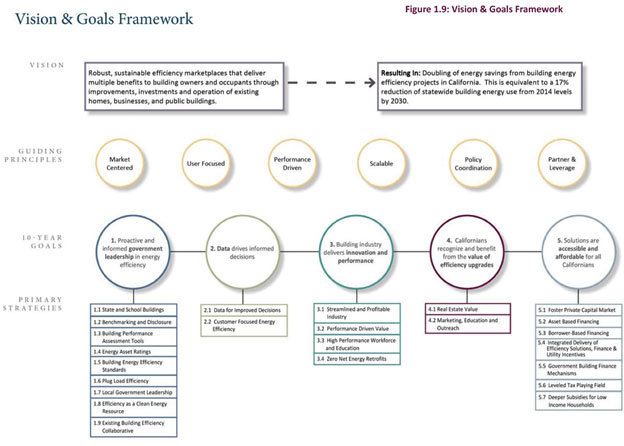 Earlier this year, the California Energy Commission (CEC) released its draft Existing Buildings Energy Efficiency (EBEE) Action Plan as a component of the implementation of AB758. While implementation is a glacial process, it gives us an idea of where the state’s energy policy is headed. And there’s much to like.
Earlier this year, the California Energy Commission (CEC) released its draft Existing Buildings Energy Efficiency (EBEE) Action Plan as a component of the implementation of AB758. While implementation is a glacial process, it gives us an idea of where the state’s energy policy is headed. And there’s much to like.
The plan calls out the key barriers that limit the broader adoption of energy efficient upgrades in existing buildings and offers strategies for overcoming those barriers. Overall, it takes a strong market-oriented approach, with interesting implications for residential green building practitioners. Below are some highlights from the action plan.
1. Modernize Asset Ratings
The commission proposes to establish energy asset ratings as the primary vehicle to incorporate energy efficiency into real estate and financial property valuations. It would do this by:
2. Standardize DataThe commission sees the need to ensure the availability, ease of access, and usability of energy consumption data for a range of purposes, including policy making, program design, targeted marketing, and market tracking. Toward that end, the commission proposes a suite of data standardization and aggregation strategies.
3. Focus on Performance
The commission seeks to focus California’s approach on performance-based efficiency solutions. This emphasis is reminiscent of Efficiency First’s calls for true performance-based program models—where incentives are linked to actual reductions in utility bills. It remains to be seen whether this model would liberate private-sector practitioners to pursue whatever delivery model makes sense in the market or whether it would simply shift the performance and financial risks from utilities to private businesses.
4. Workforce Training
The commission acknowledges the need for a highly skilled workforce to deliver the targeted level of energy efficiency gains. The plan emphasizes development of curricula to train the needed knowledge, skills, and abilities, along with new requirements for professional certifications and other measures.
It remains to be seen whether training services will effectively penetrate all segments of the workforce, particularly incumbent workers in heavily non-union trades.
Questions Remain
On the execution front, the plan leaves plenty of room for questions: It doesn’t allocate any new funding for the proposed initiatives; it relies instead on influencing the expenditures that are already on the drawing board through the Public Utilities Commission, the utilities, and the local governments. The plan also doesn’t grapple with the current system’s administrative complexity, which often seems to thwart good program design and implementation. Those issues are clearly out of scope for the Action Plan, and yet the Plan’s ultimate success may hinge on how those issues get resolved.
The devil, of course, will be in the details. A good plan must be coupled with good execution for success.
If you’d like to play a part in shaping the CEC’s proposed action plan, you can review the full plan and offer your comments here.



Alex Coba
Communication Associate
As a proud California native from Stockton, Alex brings a wealth of experience and a versatile skill set. He has a solid communication background with a Bachelor of Arts in Journalism and Public Relations from California State University, Chico. Alex is adept at strategic communications and media relations, with experience gathering and sharing stories from his local communities that uplift the unique spirit and values of those places. He is excited to join Build It Green, where he can apply his talents to further BIG’s mission to help communities across California thrive